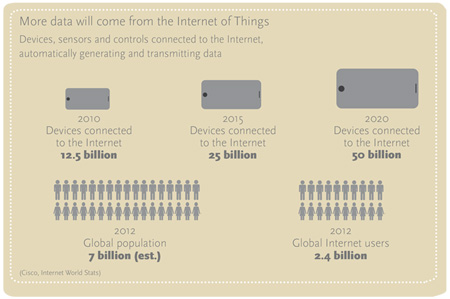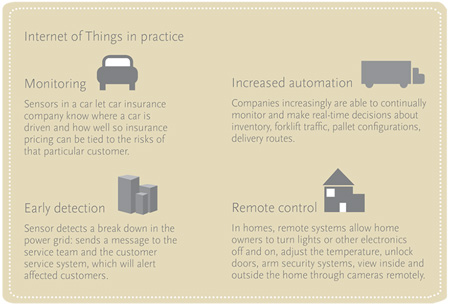Emerging as a broad yet transformational phenomenon, the so-called “Internet of Things” (IoT) is gaining attention from businesses, consumers and even governments as they envision IoT’s potential for driving efficiency, unlocking new business opportunities, and providing insights about how and when things work and advanced warning when they don’t. Also known as machine-to-machine (M2M) communication, IoT is quietly extending the same types of opportunities— and disruptions — the Internet brought to the analog world.
To truly grasp IoT’s potential, look around your office and make a mental note of all you see: the desks, the chairs, the lights, the clocks, the vending machine, the refrigerator, the coffee maker, the toaster, the microwave, your watch and your wallet. Then, glance out your window and study what’s there: pedestrians, cars, vans, trucks, cabs, trains, subway stations, billboards, traffic lights, satellite dishes, radio antennas, retail stores, restaurants and other businesses. Now consider this: In the IoT world, everything you just saw — and many other things you didn’t — may soon have the ability to interact and wirelessly communicate with each other.
Download Now >
At the core of IoT is the staggering proliferation of “smart things,” typically former analog devices and objects transformed into digital ones as the result of increasingly smaller and cheaper sensors and chips. Smart things have enabled entirely new ways of capturing and sharing information. This new data — connected to an increasingly pervasive and often wireless network infrastructure and then linked to the power (and cost) of cloud storage and computing — represents IoT’s vast potential.
The new data generated through IoT can be analyzed to drive new insights, efficiency and automation, giving life to ideas that were pure science fiction not so long ago. Often described as “the next technology revolution,” IoT is poised to dramatically change the way companies do business, how government services and utilities are provided, and how people go about their daily lives.
To capture IoT’s benefits, some industries will require large-scale capital investments and massive change programs. Others will see transformation by simply adapting commonplace technology.
What follows is a short primer about the Internet of Things and key questions for leaders.

What are the opportunities for the Internet of Things?
In a word: enormous. Cisco predicts IoT will have an economic impact of over $14 trillion by 2022, GE forecasts IoT will add $15 trillion to the world economy over the next 20 years, and the McKinsey Global Institute believes IoT has the potential to create an economic impact between $2.7 trillion and $6.2 trillion annually by 2025.
Labeling IoT as a “disruptive technology,” McKinsey believes its largest economic impacts will occur in the healthcare and manufacturing industries.
More specifically, the firm predicts:
- IoT could have an economic impact of $1.1 trillion to $2.5 trillion per year in healthcare by 2025. For example, by using smart devices that remotely monitor patients with chronic diseases — and eliminating the need for them to come into a healthcare center for a checkup — treatment costs, estimated at $15.5 trillion annually, could be slashed by as much as 20 percent a year.
- The manufacturing industry could realize an economic impact of $0.9 trillion to $2.3 trillion annually by 2025 through IoT, primarily by using low-cost sensors to drive process automation and, as a result, reducing operating costs.
Other industries poised to gain exponentially from IoT include the automotive, agriculture, electric, retail and resource extraction urban infrastructure sectors.
How much of a game-changer is the Internet of Things?
Traditionally, information-sharing and decision-making have been seen as primarily human-to-human endeavors, but as more and more data is collected and automatically shared by devices or from sensors in the world around us,humans do not necessarily need to be part of many decisions.
This fundamental shift in how data is collected, shared and analyzed is a recent phenomenon. Yet, the capabilities associated with IoT have already made a notable, if relatively small, impact on almost every industry. For example:
- When power goes down in a remote community, smart grid technology can alert an electric company and direct its repair crews to the trouble spot just as residents are beginning to notice the blackout.
- Aided by micro-cameras that move along a patient’s digestive tract, surgeons can pinpoint the source of a patient’s illness and provide treatment that is far less invasive, yet ultimately more effective, than traditional methodology.
- Equipped with facial-recognition technology, billboards are able to assess passersby — a group of teenagers, for example — and instantly change their messages to appeal to specific consumer profiles.
- With satellites delivering up-to-the-minute information on weather conditions, traffic patterns and vehicle locations, logistics managers for trucking companies can make routing decisions that steer drivers away from congestion, increasing fuel efficiency.
- Using networked sensors placed within the frames of their planes, airlines can view continuous, real-time data on aircraft wear and tear — and as result, make proactive and cost-effective decisions about maintenance while decreasing unplanned downtime.
What’s driving the growth of IoT?
Several trends are converging to enable these developments. The explosive growth of Internet-connected devices — from smart phones and tablet PCs to lower-cost sensors embedded in everything from cars and refrigerators to industrial machinery — is one. As wireless technology continues to become smaller, cheaper and more sophisticated, it is increasingly possible to consider “waking up” every office, street and traffic light or every vehicle in a country.
Another force propelling IoT development is the growing sophistication and increasing capacity of wireless networks. Rapid advances in basic computing and storage capability and cost are enabling the capture and analysis of large volumes of data at an increasing velocity.
Where are we in the development and adoption of IoT?
Some IoT applications are familiar today. For example, on the way to the office, GPS satellites may have tracked your car’s progress and displayed alternative routes on the dashboard monitor in heavy traffic. Or sensors may have automatically paid your toll, allowing you to breeze by collection booths. If you take public transportation, an app on your smart phone might have let you know when the bus or train was about to arrive at your stop.

Meanwhile, cable and phone companies are offering a new set of services for the home, allowing customers to unlock the front door, adjust the temperature and keep an eye on things remotely. And businesses are using similar technologies to track vehicles and products to improve efficiency, and sensors on industrial machines to alert about maintenance needs.
Industry experts agree that things could — and probably will — change quickly as the world becomes increasingly connected. The Cisco Visual Networking Index Services Adoption Forecast predicts that by 2017 nearly half (48 percent) of the world population will have Internet access, and 73 percent of the global population will have mobile access. The number of mobile-only Internet users — increasing at a compound annual growth rate of nearly 22 percent — is growing nearly four times faster than the number of fixed Internet users, growing at 5.9 percent CAGR. By 2020, Ericsson and others predict that there will be 50 billion Internet-connected devices, or more than 6.5 per person, compared with about two per person today.
What are the challenges to broader adoption?
Many technical hurdles, as well as privacy and security issues, must be addressed before IoT can be universally adopted. On the technology front, network technologies must further evolve to the point where “ubiquitous access” is cheap, and moving huge volumes of data quickly between the point of collection and the point of storage and analysis is highly reliable and inexpensive. Relatively “simple” technology such as energy storage in batteries must evolve to be able to provide decades of power to unconnected devices. Standards will have to emerge so that systems and devices will be able to talk to each other. And massive amounts of software and code must be developed to make these applications come to life.
From a business perspective, companies will have to invest in the technology and human resources to identify and execute creative uses of these technologies. Because IoT represents such a broad opportunity, it’s hard to identify comprehensive investment trends. In making their investment decisions, most companies will be watching the example of the early adopters to see which applications have resulted in meaningful and lasting value.
Finally, as these devices become increasingly embedded in the home, in businesses and in public services such as water and electricity utilities, security and privacy are enormous considerations. Governments are likely to closely watch the development of these applications, and create new policies and regulations regarding customer privacy and security. The U.S. Federal Trade Commission, for example, recently penalized a company that makes camera systems for home security after a security flaw allowed hackers access to live feeds inside people’s homes. As businesses and governments try to keep pace with the advancements in technology, the challenge will be to find a balance that protects consumers but allows for innovation.
What questions should the CEO and boards be asking about their companies’ capabilities in this area?
With development of IoT in relative infancy, now is an ideal time for business leaders to consider how they can utilize IoT to improve their businesses and gain a competitive advantage. Questions to raise might include:
- If our company today had ubiquitous and virtually free access to an Internet of Things, what new products services might we be able to offer?
- How might we modify our processes to reduce or eliminate manual data entry or other manual tasks?
- Looking at our analog assets (real estate, machinery, vehicles and other non-digital “things”) what business advantages could we gain by enabling them to communicate wirelessly?
- What is the state of our IT infrastructure (both software and network) and our data-analytics foundation in terms of our ability to collect data through IoT?
- To gain the most benefits from IoT, how much of our capital and resources can we expect to invest?
- Which department or division of our business is best suited for a pilot project?
- What long-standing business issues that have vexed us in the past might finally be solved with the way that IoT collects and shares data?
What are the organizational implications of adopting IoT technology and applications?
The agile, multidisciplinary approach to product and business model development that characterizes most digital businesses is rooted in a culture of “test and learn.” Learning how to capitalize on the opportunities that IoT will enable should come fairly naturally for these businesses. Although capital-intensive organizations — those most closely related to physical things — are arguably the organizations that could reap the greatest benefits from IoT, they tend to be the least prepared.
One way of discovering the opportunities enabled by IoT can be to think about it as a Kaizen model of “use cases” in which everyone in the organization, from the CEO to front-line employees, are empowered and expected to see opportunity not just for productivity gains but for creating new operating and business approaches based on new data and new ways to work with that data.
While experts may be required for implementation, the use cases should begin with the people most familiar with the business, allowing them to brainstorm the infinite possibilities for business transformation.
More broadly, IoT will likely require new business unit structures to grow new lines of business, new channels to monetize them and new expertise in technology and analytics. For CEOs and management teams, this means recruiting executives from more diverse industry backgrounds to spur innovation in areas less central to the core business, as well as to create and manage the newly imagined businesses.